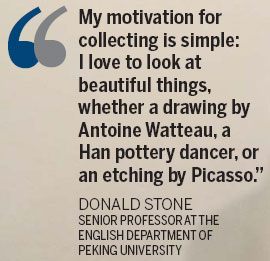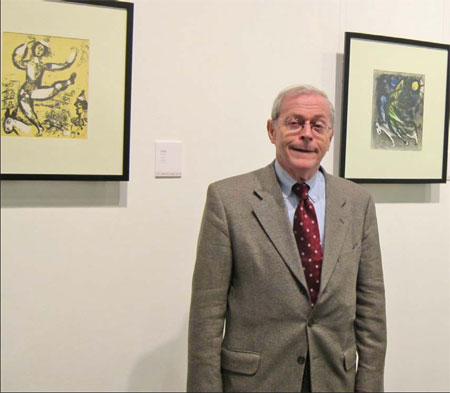Art of giving
Updated: 2012-02-24 08:40
By Lin Jing and Su Zhou (China Daily)
|
||||||||
|
Provided to China Daily |

US professor shares his love of art by donating works to university museum
Donald Stone's love for collecting art goes back to his childhood, when he started acquiring cheap postcard reproductions of paintings as a 10-year-old. When he was 17, Stone bought a Rembrandt etching before he began collecting paintings.
"I could not afford to buy master paintings, but I could occasionally afford prints and drawings by some of the same artists that I loved," he says.
Now 70, Stone says he continues to collect "minor works by major artists and major works by minor artists". His collections are confined to three areas, the Old Master (Western) drawings, the Master prints and Chinese art, including antiquities and paintings.
But unlike many art collectors including a growing number of wealthy Chinese who think of their collections as financial investments, Stone donates his precious possessions "to share with other people".
Stone, who is a senior professor at the English Department of Peking University (PKU), has already donated five sets of artworks including 200 etchings, lithographs and woodcuts of Western master prints and some Chinese antiquities to the Arthur M. Sackler Museum of Art and Archaeology at PKU.
"I think it's a mistake to think of art as an investment, although many people do in China and the West," Stone says.
"By now, all the major Western masterpieces are owned by museums, so whatever comes up for sale is rarely of top quality.
"My motivation for collecting is simple: I love to look at beautiful things, whether a drawing by Antoine Watteau, a Han pottery dancer, or an etching by Picasso," he says.
"By donating these pieces I have the additional pleasure of sharing them with other people."
Stone currently lives in New York. He has been a visiting professor at Harvard and New York universities and has spoken at many other premier institutions such as Stanford, Columbia, and London University.
He first came to China from the US as a visiting professor at Capital Normal University in 1982. He has also given lectures across China.
For the past six years at PKU he has been teaching selected readings in British novels, English Victorian poetry and the Western humanistic tradition.
Stone says the experience in China has changed his life dramatically.
"I think of my life in terms of 'BC' (Before China) and 'AC' (After China)," he says. "Never had I met so many brilliant students, so many wonderful colleagues, so many kind-hearted people."
Stone has similarly built up strong connections with his colleagues and students. According to Hong Huimin, an undergraduate at PKU, Stone is generous and thoughtful with the teachers and students.
Many call him "Grandpa Stone".
"Grandpa Stone always says 'they (collections) will ultimately go to the Sackler Museum'," writes Hong to her friends on social networking websites.
"When he negotiates with dealers, Grandpa Stone will say the 'Sackler Museum needs this (artwork) very much'."
PKU's Sackler Museum opened in 1993 and is named after Arthur M. Sackler, a prominent US pharmacologist, philanthropist and collector of art treasures who also lends his name to the renowned Arthur M. Sackler Museum, part of the Harvard Art Museums.
The collections at PKU's Sackler Museum include a set of stone prints that depict the first time Shakespeare's play was staged in Paris. Only two museums in the world are said to have the complete sets.
Stone says there is a need in China to collect Western art and it will be better to introduce them to the students at PKU, also known as Beida and considered the country's top university.
"In America, most great universities have permanent art collections - gifts of the college alumni," he says. "Moreover, Yale, Princeton, Harvard all have excellent collections of Chinese art. So why shouldn't PKU have a decent collection of Western art?"
Zhao Chaohong, the curator of PKU's Sackler Museum, says the museum has many collections on ancient cultural relics, but is still short in terms of modern art.
Stone's donations help enrich this category, Zhao says.
Since Stone buys art with only his teacher's salary and pension, he has to sell other pieces from his collection to acquire new ones.
He also visits many major print dealers frequently in the West for good quality, affordable art. Besides some well-known Western artists, he shows interest in the works of Chinese ones.
Stone's first donation was a drawing by a French artist of the 19th century. He gave it to the National Gallery of Art in Washington about 20 years ago.
The curator of drawings at the National Gallery, who is Stone's good friend, also donated four pieces from her own collection to the current Sackler exhibition at PKU. The exhibition includes works by Bruegel, Rembrandt and Chagall, and ends on March 3.
"So I felt that by buying drawings for Washington I was helping to add to the National Gallery's collection, honor a friend, and honor my country at the same time," Stone says.
He counts the following artworks as some of his personal favorites: a painting by contemporary Chinese artist Liu Yongming (a student of famous painter Wu Guanzhong) of Two Magpies, and two watercolors painted by William Alexander, the British artist who accompanied statesman George Macartney on his mission to China in 1793.
"I love the work of this painter and I love the Beida magpies," Stone says. "And these (watercolors are) exceedingly rare works, painted in China and subsequently engraved in England, and are of enormous importance as records of how China looked to Western eyes in the 18th century."
The professor will return to PKU for the autumn 2012 semester. He will then plan an exhibition of 18th century Western prints for its Sackler Museum.
Stone hopes there will be an exhibition of the museum's permanent collection of Western prints by the time it celebrates its 20th anniversary. "The sight of a great painting can be truly inspirational. I wish there were more exchanges of good-quality artworks between countries."

 Relief reaches isolated village
Relief reaches isolated village
 Rainfall poses new threats to quake-hit region
Rainfall poses new threats to quake-hit region
 Funerals begin for Boston bombing victims
Funerals begin for Boston bombing victims
 Quake takeaway from China's Air Force
Quake takeaway from China's Air Force
 Obama celebrates young inventors at science fair
Obama celebrates young inventors at science fair
 Earth Day marked around the world
Earth Day marked around the world
 Volunteer team helping students find sense of normalcy
Volunteer team helping students find sense of normalcy
 Ethnic groups quick to join rescue efforts
Ethnic groups quick to join rescue efforts
Most Viewed
Editor's Picks

|

|

|

|

|

|
Today's Top News
Chinese fleet drives out Japan's boats from Diaoyu
Health new priority for quake zone
Inspired by Guan, more Chinese pick up golf
Russia criticizes US reports on human rights
China, ROK criticize visits to shrine
Sino-US shared interests emphasized
China 'aims to share its dream with world'
Chinese president appoints 5 new ambassadors
US Weekly

|

|







